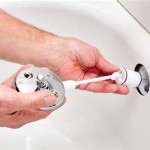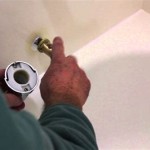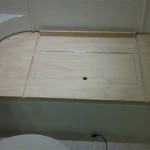Bathtub Faucet Stem Stuck: Diagnosis and Solutions
A stuck bathtub faucet stem represents a common plumbing issue encountered in residential settings. The stem, a crucial component within the faucet assembly, controls the flow of water. When it becomes immovable, the homeowner faces difficulties in turning the water on or off, leading to wastage and potential inconvenience. Understanding the underlying causes and possessing the knowledge to address them effectively can mitigate the consequences and restore the faucet to its proper function.
The primary function of the faucet stem is to regulate water flow to the bathtub. It achieves this through a series of intricate components and mechanisms. The stem usually consists of a threaded shaft, a handle attachment point, and a rubber or ceramic washer at the end. When the handle is turned, the stem moves linearly within the faucet body, either compressing or releasing the washer against the valve seat. This action either blocks or allows water to pass through the valve seat and into the bathtub spout. Over time, various factors can impede the smooth movement of the stem, causing it to become stuck and hindering the proper operation of the faucet.
Common Causes of a Stuck Bathtub Faucet Stem
Several factors contribute to the seizing of a bathtub faucet stem. Identifying the specific cause is crucial for selecting the appropriate remediation strategy. Ignoring the root cause can lead to recurring problems and potential damage to the plumbing system.
Mineral Buildup: Hard water, rich in minerals like calcium and magnesium, is a prevalent issue in many regions. As water flows through the faucet, these minerals can precipitate and accumulate within the valve body and around the stem. This buildup, commonly referred to as limescale or scale, can encrust the stem, significantly increasing friction and restricting its movement. The mineral deposits act as an adhesive, effectively binding the stem to the surrounding components. The severity of the buildup depends on the hardness of the water and the frequency of faucet usage.
Corrosion: Corrosion is another significant contributor to stuck faucet stems, particularly in older plumbing systems. Over time, the metal components of the faucet, especially those made of brass or other alloys, can undergo oxidation when exposed to water and air. This process leads to the formation of rust or other corrosive products, which can seize the stem and other moving parts within the faucet. The presence of certain chemicals in the water can accelerate the corrosion process. Corroded parts not only restrict movement but also compromise the structural integrity of the faucet, potentially leading to leaks and eventual failure.
Worn or Damaged Washers: The rubber or ceramic washer at the end of the faucet stem is responsible for creating a watertight seal against the valve seat. Over time, this washer can degrade due to normal wear and tear, exposure to chemicals in the water, or excessive pressure. A worn or damaged washer can swell, become brittle, or even break apart. These changes can increase friction against the valve seat, making it difficult to turn the stem. In some cases, the deteriorated washer can lodge itself within the valve body, further obstructing the stem's movement. Recognizing the condition of the washer is critical during faucet repair.
Sediment Accumulation: Even in water systems with proper filtration, small particles of sediment, such as sand, dirt, or pipe scale, can find their way into the faucet. These particles can accumulate within the valve body and around the stem, creating a gritty paste that increases friction and restricts movement. The accumulation of sediment is more prevalent in older plumbing systems with corroded pipes, as the corrosion byproducts themselves contribute to the sediment load. Regular flushing of the plumbing system can help minimize sediment buildup, but periodic cleaning of the faucet components is often necessary.
Diagnosis and Preliminary Steps
Before attempting to free a stuck faucet stem, a thorough diagnosis is essential. This involves carefully examining the faucet, identifying potential causes, and gathering the necessary tools and materials. Proper preparation can prevent further damage and ensure a successful repair.
Visual Inspection: Begin by visually inspecting the faucet for any obvious signs of damage or corrosion. Look for rust, mineral deposits, or cracks in the handle or faucet body. Check the area around the faucet base for leaks, as these can indicate worn or damaged seals. Note the type of faucet (e.g., compression, ball, cartridge, or ceramic disc) as the repair procedures vary depending on the design.
Water Shut-Off: Before disassembling the faucet, it is crucial to shut off the water supply to the bathroom or the specific faucet. Locate the shut-off valves, typically located under the sink or in the basement. Turn the valves clockwise until they are completely closed. After shutting off the water, open the faucet to relieve any remaining pressure in the pipes. This step prevents water from gushing out when the faucet is disassembled.
Preparation of Tools and Materials: Gather the necessary tools and materials before commencing the repair. Essential tools include a screwdriver (both flathead and Phillips head), an adjustable wrench, penetrating oil, a faucet stem puller (optional), pliers, and possibly a hammer (used with caution). Necessary materials may include replacement washers, O-rings, plumbers grease, and a new faucet stem if the existing one is severely damaged. Having all the necessary items readily available streamlines the repair process.
Methods for Freeing a Stuck Faucet Stem
Several methods can be employed to free a stuck bathtub faucet stem, ranging from simple techniques to more involved procedures. The choice of method depends on the severity of the issue and the type of faucet.
Penetrating Oil Application: Penetrating oil, such as WD-40 or Liquid Wrench, is a valuable tool for loosening stuck faucet stems. Apply the oil liberally around the base of the stem where it enters the faucet body. Allow the oil to soak for at least 15-30 minutes, giving it time to penetrate the mineral deposits or corrosion and loosen the stem. After soaking, gently try to turn the handle. If it still resists, apply more oil and wait longer. In some cases, multiple applications and longer soaking times may be necessary. The penetrating oil works by dissolving mineral buildup and lubricating the moving parts.
Gentle Tapping: If penetrating oil alone is insufficient, gentle tapping with a hammer can help break the bond between the stem and the faucet body. Protect the faucet surface with a cloth or piece of wood to prevent scratching. Lightly tap around the stem with the hammer, being careful not to apply excessive force. After tapping, try to turn the handle again. The vibrations from the tapping can help dislodge mineral deposits or corrosion that are preventing the stem from moving. This method should be used in conjunction with penetrating oil for optimal results.
Using a Faucet Stem Puller: A faucet stem puller is a specialized tool designed to remove stuck faucet stems without damaging the faucet body. The puller typically consists of a threaded rod, a handle, and a set of jaws that grip the stem. To use the puller, attach the jaws to the stem and tighten the threaded rod. This applies pressure to the stem, pulling it out of the faucet body. Faucet stem pullers are particularly useful for removing stems that are severely corroded or encrusted with mineral deposits. Using a puller reduces the risk of damaging the faucet body, which can occur when using more forceful methods.
Disassembly and Cleaning: If the previous methods fail, the faucet must be disassembled to access and clean the stem. Consult the faucet's repair manual or online resources for step-by-step disassembly instructions. Carefully remove the handle, trim, and any other components necessary to access the stem. Once the stem is exposed, thoroughly clean it with a wire brush or sandpaper to remove mineral deposits and corrosion. Clean the interior of the faucet body as well. After cleaning, lubricate the stem with plumbers grease before reassembling the faucet. This method allows for a more thorough cleaning and inspection of the faucet components.
Replacement of Damaged Parts: During disassembly and cleaning, carefully inspect the stem, washers, O-rings, and other components for damage. If any parts are worn, cracked, or corroded, replace them with new ones. Using damaged parts can lead to recurring problems and leaks. When replacing parts, ensure that they are compatible with the specific faucet model. Using incorrect parts can damage the faucet and prevent it from functioning properly. Replacement parts are typically available at hardware stores or plumbing supply stores.
Addressing a stuck bathtub faucet stem requires a systematic approach, moving from less invasive to more invasive methods. Patience and careful execution are essential to avoid damaging the faucet or plumbing system. If the problem persists despite these efforts, consulting a qualified plumber is recommended.

Plumbing Stuck Bathtub Faucet Stem Home Improvement Stack Exchange

Plumbing How To Un Faucet Valve Stem When It S Stuck Home Improvement Stack Exchange

Plumbing Fixture Faucet Stem Stuck In The Home Improvement Stack Exchange

Replacing A Stuck Moen Shower Valve Cartridge

How To Fix A Stuck Bathtub Spout Leaking

American Standard Tub Faucet Handle Stuck On Stem Doityourself Com Community Forums

How To Remove Stuck Shower Diverter Stem

Shower Diverter Stuck Out And Open Replace

How To Remove A Stuck Moen Shower Cartridge 1200 1225 1222

Plumbing How To Un Faucet Valve Stem When It S Stuck Home Improvement Stack Exchange
Related Posts








